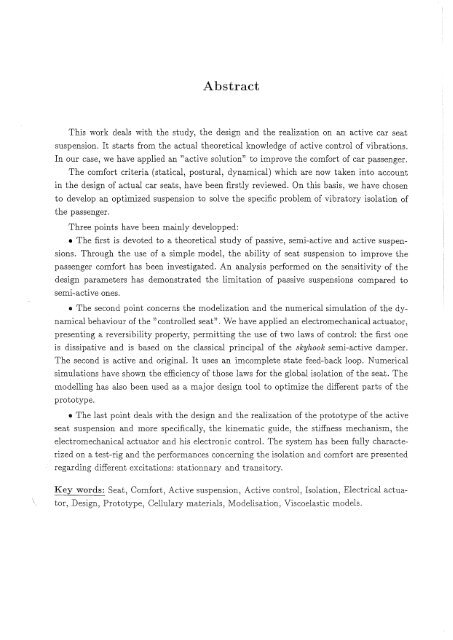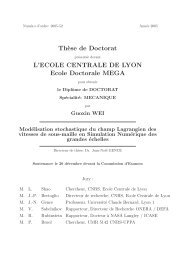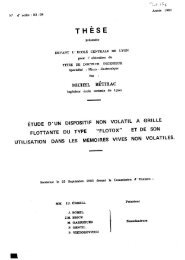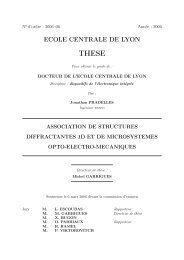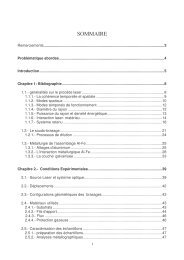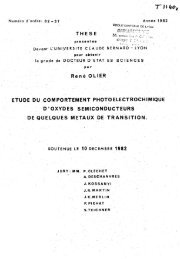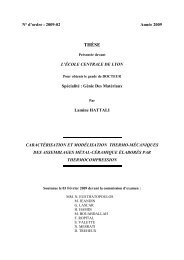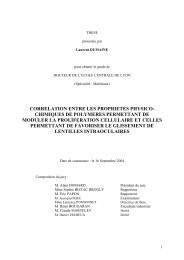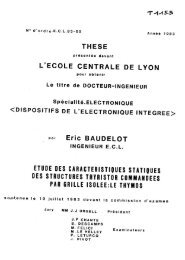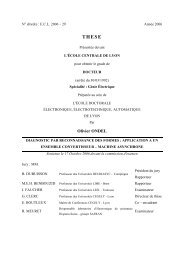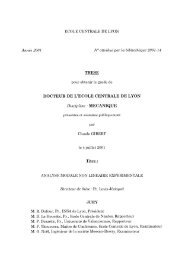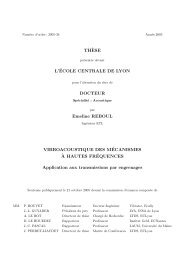- Page 1: N° d'ordre: 1997- Année 1997THÈS
- Page 5: RésuméCe travail porte sur l'étu
- Page 10 and 11: iiSommaire1.5.3 Les différentes ap
- Page 12 and 13: IVSomma,i re5.2 Conception des sous
- Page 14 and 15: viSommaireD Fiche de calcul d'un re
- Page 16 and 17: 9 IntroductionActuellement, l'enjeu
- Page 19 and 20: Chapitre 1Contexte de l'étude1.1 I
- Page 21 and 22: 1.2 L'environnement vibratoire dans
- Page 23 and 24: 1.2 L'environnement vibratoire dans
- Page 25 and 26: .2 L'environnement vibratoire dans
- Page 27 and 28: 1.2 L'environnement vibratoire dans
- Page 29 and 30: 1.3 Les différents critères de co
- Page 31 and 32: 1.3 Les différents critères de co
- Page 33 and 34: 1.3 Les différents critères de co
- Page 35 and 36: 1.3 Les différents critères de co
- Page 37 and 38: 1.3 Les différents critères de co
- Page 39 and 40: 1.3 Les différents critères de co
- Page 41 and 42: 1.3 Les différents critères de co
- Page 43 and 44: 1.3 Les différents critères de co
- Page 45 and 46: 1.3 Les différents critères de co
- Page 47 and 48: 1.3 Les différents critères de co
- Page 49 and 50: 1.4 Description des problématiques
- Page 51 and 52: 1.4 Description des problématiques
- Page 53 and 54: 1.4 Description des problématiques
- Page 55 and 56: 1.5 Étude du comportement de la, m
- Page 57 and 58:
1.5 Étude du comportement de la mo
- Page 59 and 60:
1.5 Étude du comportement de la mo
- Page 61 and 62:
1.5 Étude du comportement de la mo
- Page 63 and 64:
1.5 Étude du comportement de la mo
- Page 65 and 66:
1.5 Étude du comportement de la mo
- Page 67 and 68:
1.5 Étude du comportement de la mo
- Page 69 and 70:
1.5 Étude du comportement de la mo
- Page 71 and 72:
1.5 Étude du comportement de la mo
- Page 73 and 74:
1.5 Etude du comportement de la mou
- Page 75 and 76:
1.5 Étude du comportement de la mo
- Page 77 and 78:
1.5 Étude du comportement de la mo
- Page 79 and 80:
1.5 Étude du comportement de la mo
- Page 81 and 82:
1.6 Hypothèses de l'étude 67loi d
- Page 83:
1.7 Conclusions 69nous avons décou
- Page 86 and 87:
72 Chap. 2. Étude de l'isolation v
- Page 88 and 89:
74 Chap. 2. Étude de l'isolation v
- Page 90 and 91:
Chap. 2. Étude de l'isolation vibr
- Page 92 and 93:
73 Chap. 2. Étude de l'isolation v
- Page 94 and 95:
80 Chap. 2. Étude de l'isolation v
- Page 96 and 97:
82 Chap. 2. Étude de l'isolation v
- Page 98 and 99:
84 Chap. 2. Étude de l'isolation v
- Page 100 and 101:
86 Chap. 2. Étude de l'isolation v
- Page 102 and 103:
88 Chap. 2. Étude de l'isolation v
- Page 104 and 105:
90 Chap. 3. Rappels sur la théorie
- Page 106 and 107:
92 Chap. 3. Rappels sur la théorie
- Page 108 and 109:
94 Chap. 3. Rappels sur la théorie
- Page 110 and 111:
96 Chap. 3. Rappels sur la théorie
- Page 112 and 113:
98 Chap. 3. Rappels sur la théorie
- Page 114 and 115:
100 Chap. 3. Rappels sur la théori
- Page 116 and 117:
102 Chap. 3. Rappels sur la théori
- Page 118 and 119:
104 Chap. 3. Rappels sur la théori
- Page 120 and 121:
106 Chap. 3. Rappels sur la théori
- Page 122 and 123:
108 Chap. 3. Rappels sur la théori
- Page 124 and 125:
110 Chap. 3. Rappels sur la théori
- Page 126 and 127:
112 Chap. 3. Rappels sur la théori
- Page 129 and 130:
Chapitre 4La suspension active du s
- Page 131 and 132:
4.2 Modélisation du système 1174.
- Page 133 and 134:
4.2 Modélisation du système 119en
- Page 135 and 136:
4.2 Modélisation du système 121u(
- Page 137 and 138:
4.2 Modélisation du système 1232.
- Page 139 and 140:
4.2 Modélisation du système 125Le
- Page 141 and 142:
4.3 Lois de commandes et simulation
- Page 143 and 144:
4.3 Lois de commandes et simulation
- Page 145 and 146:
4.3 Lois de commandes et simulation
- Page 147 and 148:
4.3 Lois de commandes et simulation
- Page 149 and 150:
4.3 Lois de commandes et simulation
- Page 151 and 152:
4.3 Lois de commandes et simulation
- Page 153 and 154:
4.3 Lois de commandes et simulation
- Page 155 and 156:
4.3 Lois de commandes et simulation
- Page 157 and 158:
4.3 Lois de commandes et simulation
- Page 159 and 160:
4.3 Lois de commandes et simulation
- Page 161 and 162:
4.3 Lois de commandes et simulation
- Page 163 and 164:
4.3 Lois de commandes et simulation
- Page 165 and 166:
4.3 Lois de commandes et simulation
- Page 167 and 168:
4.3 Lois de commandes et simulation
- Page 169 and 170:
4.3 Lois de commandes et simulation
- Page 171 and 172:
4.3 Lois de commandes et simulation
- Page 173 and 174:
4.3 Lois de commandes et simulation
- Page 175 and 176:
4.3 Lois de commandes et simulation
- Page 177 and 178:
4.4 Conclusions 1634.4 ConclusionsL
- Page 179 and 180:
Chapitre 5Prototype de la suspensio
- Page 181 and 182:
Description du prototypeFig. 5.3 -
- Page 183 and 184:
•5.2 Conception des sous-ensemble
- Page 185 and 186:
5.2 Conception des sous-ensemhles m
- Page 187 and 188:
5.2 Conception des sous-ensembles m
- Page 189 and 190:
5.2 Conception des sous-ensembles m
- Page 191 and 192:
5.2 Conception des sous-ensembles m
- Page 193 and 194:
5.2 Conception des sous-ensembles m
- Page 195 and 196:
5.2 Conception des sous-ensembles m
- Page 197 and 198:
5.2 Conception des sous-ensembles m
- Page 199 and 200:
5.2 Conception des sous-ensembles m
- Page 201 and 202:
5.2 Conception des sous-ensembles m
- Page 203 and 204:
5.2 Conception des sous-ensembles m
- Page 205 and 206:
5.3 Conception de la partie command
- Page 207 and 208:
5.3 Conception de la partie command
- Page 209 and 210:
5.3 Conception de la partie command
- Page 211 and 212:
5.4 Identification des paramètres
- Page 213 and 214:
5.4 Identification des paramètres
- Page 215:
5.5 Conclusions 201rendement maximu
- Page 218 and 219:
204 Chap. 6. Résultats expériment
- Page 220 and 221:
206 Chap. 6. Résultats, expérimen
- Page 222 and 223:
208 Chap. 6. Résultats expériment
- Page 224 and 225:
210 Chap. 6. Résultais expériment
- Page 226 and 227:
212 Chap. 6. Résultats expériment
- Page 228 and 229:
214 Chap. 6. Résultats expériment
- Page 230 and 231:
216 Chap. 6. Résultats expériment
- Page 232 and 233:
218 Chap. 6. Résultats expériment
- Page 234 and 235:
220 Chap. 6. Résultats expériment
- Page 236 and 237:
222 ' Chap. 6. Résultats expérime
- Page 238 and 239:
224 Chap. 6. Résultats expériment
- Page 240 and 241:
226 Chap. 6. Résultats expériment
- Page 242 and 243:
228 Chap. 6. Résultats expériment
- Page 244 and 245:
230 Chap. 6. Résultats expériment
- Page 246 and 247:
232 Chap. 6. Résultats expériment
- Page 248 and 249:
234 Chap. 6. Résultats expériment
- Page 250 and 251:
:/236 Chap. 6. Résultats expérime
- Page 252 and 253:
238 Chap. 6. Résultats expériment
- Page 254 and 255:
240 Chap. 6. Résultats expériment
- Page 256 and 257:
242 Conclusions et perspectivesde p
- Page 258 and 259:
244 Conclusions et perspectivesi->
- Page 260 and 261:
246 Conclusions et perspectivesmod
- Page 263 and 264:
Bibliographie[1] Moteurs électriqu
- Page 265 and 266:
Références bibliographiques 251[2
- Page 267 and 268:
Références bibliographiques 253[5
- Page 269 and 270:
Références bibliographiques 255[8
- Page 271 and 272:
Références bibliographiques 257[1
- Page 273 and 274:
Annexe AContrôlabilité-observabil
- Page 275 and 276:
Annexe BStabilité-robustesse d'un
- Page 277 and 278:
Annexe B : Stabilité-Robustesse d'
- Page 279 and 280:
Annexe B: Stabilité-Robustesse d'u
- Page 281 and 282:
Annexe B : Stabilité-Robustesse d'
- Page 283:
Annexe B : Stabilité-Robustesse d'
- Page 286 and 287:
272 AnnexesCette équation complexe
- Page 289 and 290:
Annexe DFiche de calcul d'un ressor
- Page 291:
Annexe D: Fiche de calcul d'un ress
- Page 294 and 295:
280 Annexes- Accumulateur HP (V = 0


